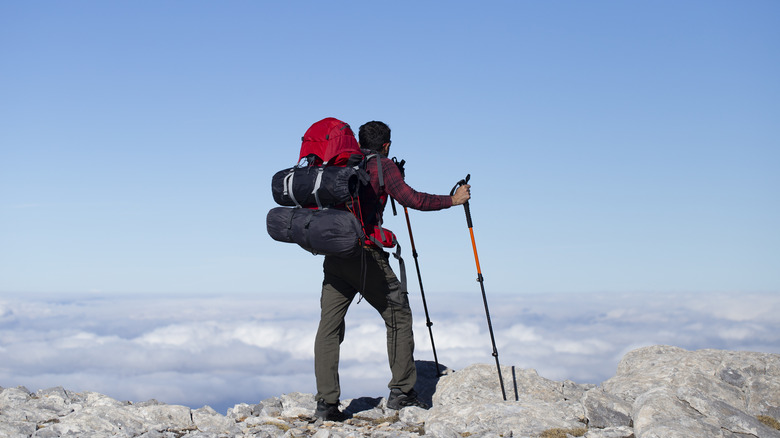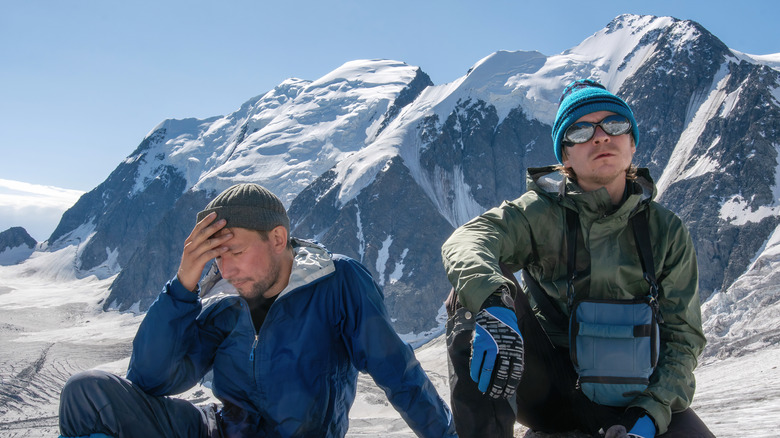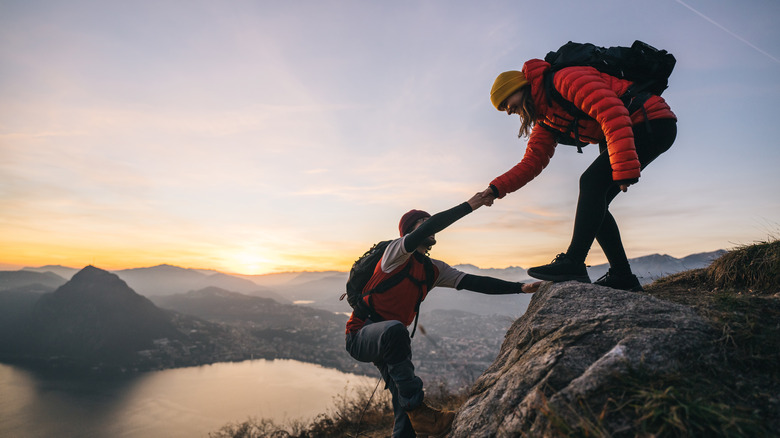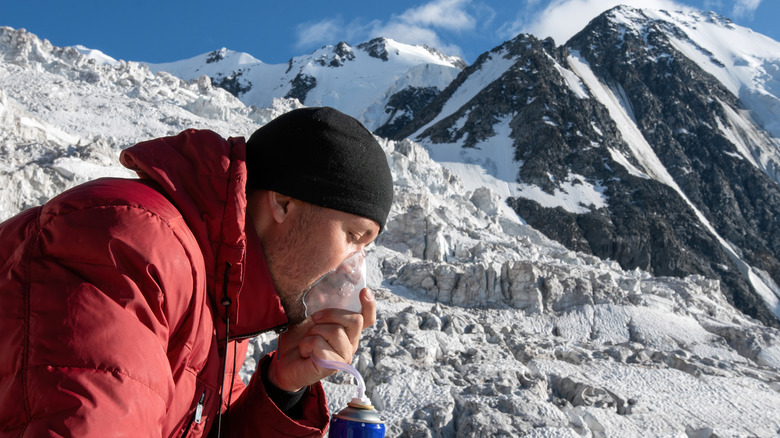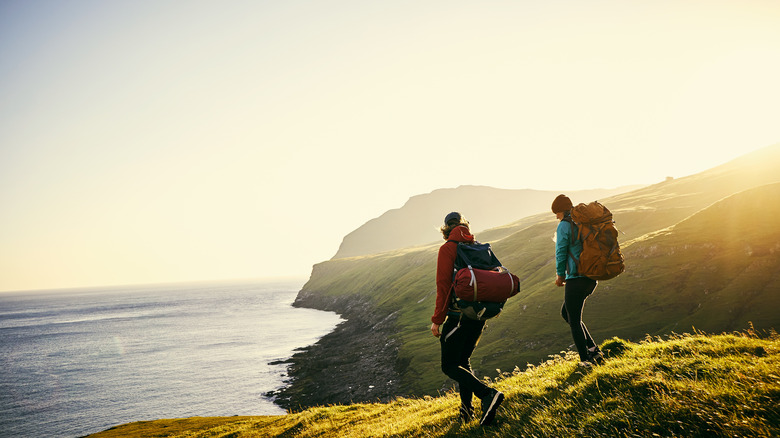The Best Things To Do When You Experience Altitude Sickness On A Hike
Imagine yourself hiking to the top of a mountain. The views are spectacular and you're having a blast. Gradually, you begin to feel a headache coming on. Maybe you start to feel a little nauseated and dizzy. When your hiking buddy offers you a snack, you just have no appetite, and everything feels a bit off. You may have been hit with altitude sickness.
As humans climb to higher elevations too rapidly, certain things happen. The air will get colder, you'll have less humidity and more ultraviolet radiation, but most importantly, your ability to take in oxygen decreases. If you don't have enough oxygen in your blood, hypoxia sets in and can cause a host of problems.
There are several factors that go into who gets altitude sickness. Some of it is genetic, some of it is how fast you rise in elevation, and, of course, how high you're going. It can happen as you ascend in a plane or a car, and it can happen while hiking. Though you may be able to recover on your own, in some cases you could require medical help. If it goes on too long, it can get worse and possibly (and quickly) become fatal. That said, there are things you can do to prevent altitude sickness, and to treat it if you get it.
Different types of altitude sickness
Altitude sickness tends to hit at as low as 8,202 feet above sea level. (For comparison, people climb over 29,000 feet to summit Mount Everest.) The quicker you ascend, the less time your body has to get used to being able to use less oxygen.
There are three types of altitude sickness. First, there is acute mountain sickness (AMS). This is the most common form, and it usually happens on the first day at high elevations. In fact, many people will have some symptoms if they reach 11,000 feet too quickly. You might get a headache, feel nauseated or vomit, lose your appetite, have trouble sleeping, get dizzy or lightheaded, or you may feel a sense of malaise. Though rare, you might even have vision changes. As it gets worse, you could begin feeling clumsy (ataxia) or have shortness of breath, even when you're not actively exercising.
The other two types tend to hit within two to five days. The second type is high altitude pulmonary edema (HAPE), which can cause your lungs to fill with fluid, which can be fatal if not addressed within 12 hours. High altitude cerebral edema (HACE) is the most severe and causes brain swelling. This can kill you in 24 hours. These are medical emergencies, and you cannot play around with these conditions. There are, however, ways to combat altitude sickness and hopefully prevent it from becoming severe.
Dos and don'ts to help prevent altitude sickness
There are some things you can avoid to help prevent or reduce altitude sickness. First, you should stop using tobacco before your trip, because it can affect the level of oxygen in your blood. If you begin to get a headache or feel off, stop consuming alcohol for a few days. In fact, it's worth stopping for the first few days you're in a high altitude either way, as dehydration can make symptoms worse. Avoid sedatives as they can have the same effect. Note that if you've gotten altitude sickness before, you are more likely to have it happen again.
That said, if you're a caffeine drinker, continue to take in the same amount you usually do. (Try these travel mugs to keep coffee warm and your pack light.) Caffeine withdrawal headaches can be mistaken for altitude sickness and vice versa. If you plan on being above 8,202 feet, keep your exercise on the easy side for the first 48 hours to help your body adjust. Speak with your doctor before a trip like this, especially if you've experienced issues or if you have a preexisting condition, particularly with your respiratory system. There are some medications you can take to prevent or lessen altitude sickness. If you do experience any of the symptoms above, as well as chest tightness or pain, or slurred speech, get checked as fast as you can and descend if possible.
How to ascend safely
One of the ways to help prevent altitude sickness, or at least keep it on the milder side, is adjusting your ascent. It's not just the elevation you're ascending to — it's also how quickly you go up. When you're planning a hike to a high elevation, make sure you have enough time to adjust and ascend gradually. Try to avoid going over 9,000 feet up in a single day. In fact, the longer you can stay at each elevation, combined with doing smaller climbs can help a lot.
You'll also need to plan for more sleep. The Centers for Disease Control (CDC) recommends that, once you pass 9,000 feet, you should only sleep 1,600 feet above that each day. Plus, add in an extra day to get used to the new altitude every 3,300 feet you rise after 9,000 feet. After about 14,000 feet, you should have two days of rest for every additional thousand feet. Yes, it's a lot of math and mapping, but it's worth it. If you don't have a choice about going more quickly, there is a medication called acetazolamide that can help speed up your acclimatization, but again, consult your doctor. If you can work it in, you can also try to do a trip above 9,000 feet that lasts less than 48 hours within a month of your hike. The closer the better. Again, remember that if you climb more gradually, you're less likely to have issues.
How altitude sickness is treated
The more serious HAPE and HACE versions of altitude sickness are less common than AMS, and if you have mild symptoms like a headache or dizziness and stop climbing, it should pass in a day or two on its own. If they aren't mild or get worse, you should descend until they go away. That can be between 984 and 3,281 feet. You may be given supplemental oxygen to help bring your blood oxygen levels to normal. There are also several medications that can stop or delay symptoms which you should discuss with your doctor before you take your trip.
Another thing that doctors use to treat severe altitude sickness is hyperbaric therapy. If you're familiar with scuba diving and what happens when you divers get decompression sickness, this is similar. Some high-altitude hiking groups or emergency teams have portable hyperbaric treatments, though this shouldn't be relied on.
If you're feeling confused or dizzy, off balance, hallucinating, see blue or grey on your lips, tongue, or nails, start coughing (especially if you have froth or blood in what you cough up), or if you're unusually sleepy, get medical help immediately. Tell someone as soon as you begin to feel anything unusual.
Other tips for dealing with high altitudes
There are a few other important tips for planning a high-altitude hike. First, don't go alone. If altitude sickness can come on quickly, and if it's severe, you don't have time to waste. Having someone with you who can get or call for help is essential. Training beforehand to make sure your cardio fitness is strong is a good idea as well. There are different training programs around that specifically target this sort of training, but again, consult with your doctor. Another practice to work on is rhythmic breathing to calm down any sense of panic you may feel if you begin to feel symptoms.
Even what you put in your backpack can help with high-altitude hiking. Make sure you have enough water and electrolytes and practice drinking more than you usually would. Sweat evaporates off of your skin quicker at higher elevations and you'll be breathing more to try to get in more oxygen, which also causes you to lose water, so a proper water bottle is an ideal accessory. Bring enough food to ensure that you have extra, as you'll expend more calories than usual, as mentioned above.
Finally, do not forget to pack sunscreen (here are some reef-safe sunscreens to try) and some aloe vera gel just in case you get sunburned. The thinner atmosphere means you'll burn more quickly. Don't forget about your lips, the tops of your ears, and your scalp — especially where you part your hair.
